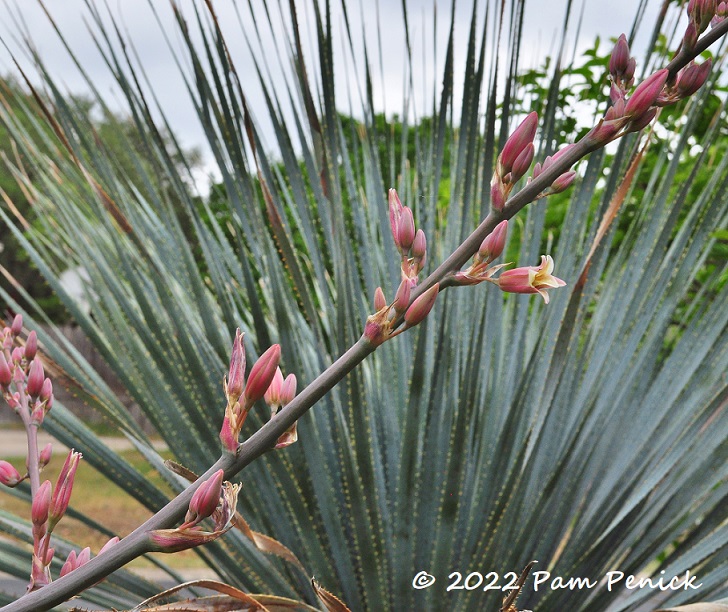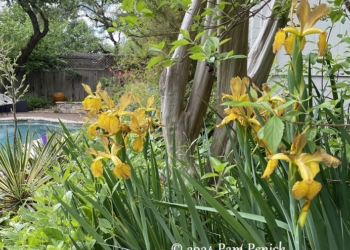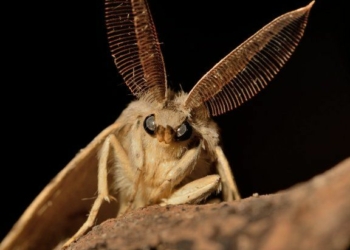May 13, 2022

Last October I had the pleasure of visiting John Ignacio’s northwest Austin garden, a treasure box of rare plants that John has collected (including on a plant-hunting expedition with the late John Fairey) and hybridized. I returned this April to see it at the beginning of the growing season, and much was in bloom including some big, beautiful hesperaloes. This hesperaloe flower wand is pictured with a sotol behind it.

I asked John if this is the Mexico native Hesperaloe campanulata that he shared with neighbor Coleson Bruce for his crevice garden. He replied that it may be, but it might also be a campanulata hybrid with our native H. parviflora. At any rate, the flowers, rose and pale yellow, are beautiful.

In the rock paving at the entrance to the garden I admired the symmetry of Agave lophantha — aka Agave univittata, as John ID’d it — loosened up with winecup (Callirhoe involucrata).

Maybe my favorite plant in John’s garden, especially as displayed in square steel pipes cut to different heights: the sotol Dasylirion berlandieri, commonly called blue twister.

What a handsome plant! That’s John’s Mayan-inspired house that he designed in the background. In the foreground, rain lilies and wildflowers were blooming in mid-April.

Blue wild indigo, aka blue false indigo (Baptisia australis var. minor), protected by a concrete block. I recently saw this blooming at the Wildflower Center and resolved to give it a try in my own garden.

A narrow grove of Texas mountain laurels and live oaks shields John’s house from the street. A limestone entry path runs lengthwise across the garden past the trees. Feathery dioons grow under the canopy.

John isn’t afraid to topiary a tree, including our native Texas mountain laurel. This one, he said, serves as an outdoor Christmas tree in December.

Standing winecup (Callirhoe digitata) makes a pretty pot display for spring.

I hadn’t seen this pale pink oxalis before (Oxalis crassipes, a light form).

John thinks he got it at the John Fairey Garden (formerly Peckerwood) or Yucca Do many years ago.

The stone path is fitted together so well. I always admire it.

Looking the other way, you see how the path leads through the front garden. It makes an L from the curb (off to the right), and then another L toward the front door (at the far end). The skinny, pale tree trunks along the left side of the walk are ‘Will Fleming’ yaupons that John severely prunes in spring to keep them very tight and upright.

Scarlet clematis (Clematis texensis) on a trellis along the path

We stopped here for a photo. Pictured with John are friends Cat and Diana.

Past the path and trees, the steel-potted Dasylirion berlandieri also help screen the road. Wildflowers and ‘Quadricolor’ agaves add sun-loving color.

Palms and cycads for evergreen foliage and texture

A shaggy palm trunk

And another dioon

Along the street, spiky sotols mingle with wildflowers spiderwort and white prickly poppy. A sotol’s bloom stalk from last season lay toppled over amid the flowers.

More hesperaloe flowers about to pop

Gulf Coast penstemon (Penstemon tenuis) looking lovely against a stone wall

And more white prickly poppy (Argemone albiflora spp. texana)

Japanese honeysuckle grows along a fence between John’s garden and his next-door neighbor’s. It’s invasive but oh so sweetly scented. I took a deep whiff, which flooded my mind with memories of running around as a child on the dirt roads at my grandmother’s place in rural Oklahoma.

John invited us to see his neighbor’s walled front garden, which John takes care of. It was bright with amaryllis, poppies, and spiderwort.

John hybridizes amaryllis and says, “These are all Hippeastrum hybrids I made that are fully hardy in the ground here. All of them made it through Snowmaggedon. They need to be much more widely planted, as they are one of the best bulbs for Central Texas.“

Hippeastrum johnsonii x H. ‘Apple Blossom’ ‘Candy Cane’

Hippeastrum johnsonii x H. ‘Red Lion’

Hippeastrum ‘Luna’ x H. ‘Evergreen’

An American Indian bust amid the poppies and amaryllis draws the eye.

As does this surprising sign: Danger: Snakes in the Grass. Oh really?

Nearby, another sign advises, “Lie on the grass if you are Young & Beautiful.” I got a laugh out of these and think there may be some double entendre going on.

We exited the neighbor’s garden through the driveway and popped into John’s backyard for a quick peek at his palmy terrace…

…and his amazing greenhouse packed to the ceiling with his collection of orchids and other tropical plants. Wow! I did not see this coming but should have. John says, “I started growing orchids when I was 16, was a judge by the time I was 23, and have been growing and hybridizing them ever since.”

A beautiful Cattleya maxima orchid in bloom

Just look at all this — and how wonderfully displayed

John has so many unique plants and collections packed into his garden, which makes every visit an exploration — and there are fun stories too. Thanks for sharing your garden again, John!
I welcome your comments. Please scroll to the end of this post to leave one. If you’re reading in an email, click here to visit Digging and find the comment box at the end of each post. And hey, did someone forward this email to you, and you want to subscribe? Click here to get Digging delivered directly to your inbox!
__________________________
Digging Deeper
Love ponds? Attend the ZENsational Pond Tour June 4-5, organized by Austin Pond Society. North Austin ponds are on tour June 4th, South Austin ponds on June 5th. One ticket gets you into both days. Early registration is $25 until May 31. Or register at any pond on May 4 or 5 for $30.
Join the mailing list for Garden Spark! Hungry to learn about garden design from the experts? I’m hosting a series of talks by inspiring designers, landscape architects, and authors a few times a year in Austin. These are limited-attendance events that sell out quickly, so join the Garden Spark email list to be notified in advance. Simply click this link and ask to be added. The 6th season kicks off in fall 2022.
All material © 2022 by Pam Penick for Digging. Unauthorized reproduction prohibited.













